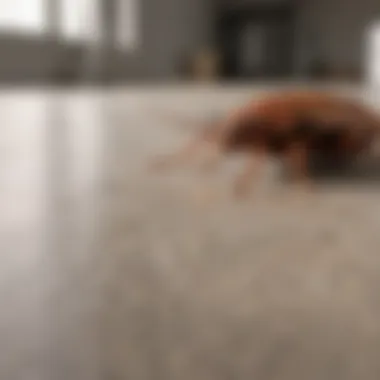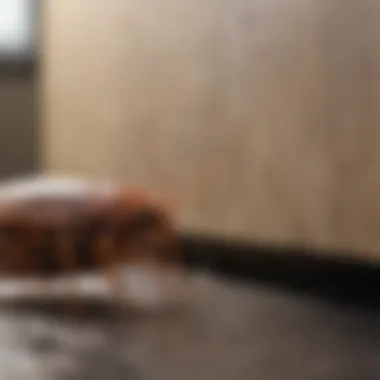Unveiling the Health Hazards of German Cockroach Infestations in Apartments


Preventive Pest Control Strategies
When it comes to safeguarding your apartment from the perils of a German cockroach infestation, strategic prevention is key. Implementing preventive pest control strategies can significantly mitigate the risk of an invasion. Starting with house exterior protection, it is imperative to seal any cracks and crevices that could serve as entry points for these unwelcome pests. Clearing debris around the perimeter of your home is also essential to eliminate potential hiding spots. Furthermore, taking proactive measures to prevent pests from entering by using barriers or mesh screens can be highly effective in deterring cockroaches.
In addition to focusing on the exterior, yard maintenance plays a crucial role in pest prevention. By adhering to essential yard care routines such as regular mowing, pruning, and eliminating standing water, you can create an environment that is less conducive to pest activity. Implementing methods to keep your yard pest-free, such as natural repellents or environmentally friendly pesticides, can further fortify your defenses against potential infestations.
Maintaining indoor cleanliness is paramount in deterring German cockroaches from infiltrating your living space. Adopting expert cleaning tips and techniques, such as decluttering, vacuuming regularly, and sealing food containers, is instrumental in creating a pest-resistant indoor environment. Moreover, proper garbage disposal practices are essential in preventing cockroaches from being attracted to your home. Enforcing efficient waste disposal methods and emphasizing the importance of proper garbage handling can go a long way in reducing the risk of an infestation.
Lastly, exploring other pest prevention strategies beyond the conventional can provide additional layers of protection for your apartment. From utilizing innovative technology like ultrasonic pest repellents to incorporating natural deterrents like diatomaceous earth, exploring diverse pest control options can enhance the overall efficacy of your prevention efforts.
Identifying Pest Risk Areas
To effectively combat the threat of a German cockroach infestation, it is essential to identify and assess potential pest risk areas within and around your apartment. Beginning with moisture-prone areas, conducting inspections to identify damp conditions can reveal areas where cockroaches are likely to thrive. By employing tips for preventing infestations in such locations, such as enhancing ventilation or repairing leaks, you can proactively address vulnerabilities.
Moreover, conducting a comprehensive crack and crevice inspection is vital in detecting access points that cockroaches may exploit to enter your living space. Understanding the importance of sealing cracks and crevices using appropriate sealants or weatherstripping can significantly reduce the chances of an infestation. Whether it is around windows, doors, or utility penetrations, sealing off these entry points is a critical aspect of pest control.
Furthermore, assessing greenery around your apartment for pest risks is crucial in identifying potential harborage sites for pests. By understanding how vegetation can impact pest activity and adopting guidelines to maintain a pest-free yard through landscaping practices like pruning bushes and clearing debris, you can create an environment that is less attractive to cockroaches.
Additionally, identifying and addressing miscellaneous pest risk areas such as attic spaces, storage areas, or crawl spaces is essential in comprehensive pest management. Taking proactive measures to seal off these less conspicuous areas and implementing preventive measures can help minimize the likelihood of a pest infestation in these overlooked spaces.
Effective Pest Control Methods
In the event of a German cockroach infestation or as part of a proactive pest management plan, employing effective pest control methods is imperative to achieve lasting results. Embracing natural repellents for pest control offers a safe and sustainable alternative to traditional chemical treatments. Utilizing essential oils, herbs, and plants known for their pest-repelling properties can help deter cockroaches without the need for harsh chemicals.
While natural remedies are valuable, chemical sprays remain a potent tool in combating severe infestations. When using professional sprays, it is crucial to follow safety guidelines and only apply them in targeted areas to eradicate pests effectively. Chemical solutions formulated specifically for cockroach control can eradicate these tenacious pests and prevent their resurgence when applied strategically.
For capturing and removing pests like German cockroaches, pest traps serve as effective control solutions. Setting up traps in areas of high cockroach activity and regularly monitoring them can help in identifying the extent of the infestation and reducing the population gradually. By employing both adhesive traps and pheromone-based traps, you can address the infestation from multiple angles.
Integrating biological control methods in your pest prevention arsenal can offer a sustainable and eco-friendly approach to managing pests. For instance, introducing natural predators of cockroaches, such as certain species of spiders or parasitic wasps, can help keep their population in check without resorting to chemical interventions. By fostering a balanced ecosystem in your apartment, you can leverage biological controls for long-term pest management.
In addition to the aforementioned methods, exploring other pest control techniques beyond the traditional can provide innovative solutions for pest management. From electronic devices that emit sound frequencies to repel pests to utilizing physical barriers like netting or caulking, diversifying your pest control tactics can enhance the overall effectiveness of your strategy.
Pest Species Identification
A crucial aspect of effective pest control is the ability to identify different pest species that may pose a threat to your apartment. Recognizing common insects that are prevalent in homes, such as ants, cockroaches, and spiders, is fundamental in implementing targeted control measures. By understanding the behavior and habits of these insects, you can employ strategies that are specific to each type of pest.
When it comes to rodent infestations, being able to identify types of rodents like mice and rats is essential for developing preventive measures. Implementing proactive steps such as sealing entry points, storing food securely, and maintaining cleanliness can help deter rodents from entering your living space. By recognizing the signs of a rodent infestation early on, you can take swift action to address the issue.
Furthermore, bird species can also impact home environments, especially in urban settings where certain birds may pose a nuisance or health risk. Addressing bird-related issues around your apartment, such as nesting or roosting on buildings, can prevent potential damage and sanitation issues. By understanding the behavior of troublesome bird species and implementing humane deterrent measures, you can create a bird-free environment.
Dealing with wildlife encounters on your property requires a cautious approach to ensure both your safety and the well-being of the wildlife. Whether it involves encountering raccoons, squirrels, or skunks, being aware of their behaviors and employing humane control measures can resolve conflicts peacefully. By implementing strategies like securing trash bins or removing attractants, you can minimize the chances of wildlife intrusion.


Lastly, addressing miscellaneous pest species that may not be as well-known but can still pose a threat is essential in comprehensive pest identification. From pantry pests like beetles or moths to occasional invaders like centipedes or pill bugs, recognizing these lesser-known pests can help in formulating targeted control strategies tailored to each species.
DIY Pest Control Techniques
When it comes to managing pest infestations in your apartment, having knowledge of practical do-it-yourself (DIY) pest control techniques can empower you to take proactive measures. Utilizing homemade pest control solutions offers an eco-friendly and cost-effective approach to pest management. By creating remedies using household ingredients such as vinegar, baking soda, or citrus oils, you can fend off pests effectively.
Harnessing the power of essential oils for pest control is another natural method to repel insects like cockroaches. By blending essential oils with water and creating a spray, you can create a fragrant yet effective barrier against pests. Citronella, peppermint, and lavender oils are known for their insect-repelling properties and can be used strategically to deter pests.
Setting up effective pest traps and barriers in targeted areas of your apartment can help in capturing and controlling pest populations. Whether it involves devising DIY traps using household items or installing physical barriers like weather-stripping or door sweeps, creating obstacles for pests can impede their movement and breeding cycles.
For those seeking reputable pest control products from trusted brands, a wide range of options is available to safeguard your home. These products, ranging from insecticides to traps, are formulated to target specific pests and provide reliable means of pest management. By choosing reputable brands known for their effectiveness and safety, you can enhance the overall protection of your apartment.
Exploring miscellaneous DIY pest control techniques can often yield unexpected solutions to common pest problems. Whether it involves using natural deterrents like garlic or chili powder, or implementing physical barriers like copper mesh or caulk, diversifying your DIY approaches can offer versatile strategies for combating pests effectively.
By incorporating a combination of preventive measures, effective control methods, species identification, and practical DIY techniques, you can equip yourself with a comprehensive understanding of managing German cockroach infestations in apartments. Remember that a proactive approach to pest control is key in safeguarding your home environment and ensuring the well-being of your household.
Introduction
German cockroach infestations in apartments pose significant health and safety hazards, necessitating immediate attention and effective eradication methods. These resilient pests, known for their rapid reproduction and resilience to many control measures, can quickly escalate from a minor nuisance to a full-blown infestation if left unchecked. Understanding the behavior, life cycle, and risks associated with German cockroaches is crucial in combating their presence and safeguarding your living environment. By delving into the nuances of this issue, this article aims to shed light on the urgency of addressing and preventing German cockroach infestations in apartments to ensure the well-being of residents and the integrity of the living space.
Understanding German Cockroaches
German cockroaches are a prevalent pest species known for their ability to thrive in urban environments, particularly in apartment settings. Understanding the characteristics and behaviors of German cockroaches is crucial in dealing with infestations effectively.
Physical Characteristics
German cockroaches are light brown to tan in color, with two dark stripes running down their backs. Typically measuring around 1/2 to 5/8 inches long, these insects have six legs and antennae. Their flattened bodies allow them to squeeze into tiny cracks and crevices with ease, aiding in their elusive nature within apartment spaces.
Beyond their appearance, German cockroaches possess wings but are unable to sustain extended flights, relying on their adeptness at climbing and scurrying across various surfaces.
Behavioral Traits
German cockroaches are nocturnal creatures, preferring to remain hidden during daylight hours and emerging at night to forage for food and water. Their rapid reproductive rate contributes to the challenges of eradicating infestations, as a single female cockroach can produce numerous offspring in a short period.
These pests are attracted to warm, humid spaces and are often found near food sources and moisture-rich areas, such as kitchens and bathrooms in apartments. Their adaptable nature enables them to develop resistance to certain insecticides over time, making eradication efforts more complex.
Life Cycle
The life cycle of a German cockroach consists of three main stages: egg, nymph, and adult. After mating, female cockroaches produce egg cases known as oothecae, which can contain multiple eggs.
Once hatched, nymphs resemble smaller versions of adult cockroaches but lack wings. They undergo several molting stages before reaching adulthood, with each stage requiring specific environmental conditions to thrive.
Understanding the life cycle of German cockroaches is essential for implementing effective control measures and preventing future infestations in apartment settings.


Health Risks Associated with Infestation
When discussing the dangers of a German cockroach infestation in apartments, understanding the health risks associated with such a situation is crucial. This section sheds light on the detrimental impact these pests can have on human health, emphasizing the urgency of addressing infestations promptly to safeguard well-being.
Allergies and Asthma
One of the primary health risks posed by German cockroach infestations is the exacerbation of allergies and asthma in individuals. These pests produce proteins that can act as allergens, triggering allergic reactions and asthma attacks, particularly in sensitive individuals. The presence of cockroach droppings, shed skins, and saliva can worsen respiratory conditions and lead to breathing difficulties. Furthermore, prolonged exposure to cockroach allergens may heighten the risk of developing these conditions, making it essential to tackle infestations swiftly to mitigate health hazards.
Spread of Diseases
Apart from provoking allergies and asthma, German cockroaches can also serve as vectors for various diseases. These pests are known to carry pathogens such as Salmonella, E. coli, and other harmful bacteria on their bodies and in their feces. As they navigate through living spaces, cockroaches contaminate surfaces and food sources, facilitating the transmission of pathogens to humans. This contamination can result in foodborne illnesses, gastrointestinal infections, and other health ailments. Thus, preventing and eradicating cockroach infestations is fundamental in preventing the spread of diseases within apartment environments.
Contamination of Food and Surfaces
German cockroach infestations pose a significant risk of contaminating food and surfaces within apartments. These pests forage for food in kitchens, pantries, and dining areas, leaving behind traces of excrement, saliva, and shed skin. Such contamination compromises the cleanliness and safety of food preparation areas, leading to potential ingestion of harmful bacteria and pathogens. Additionally, cockroaches can transfer contaminants from unsanitary locations to commonly touched surfaces, heightening the risk of cross-contamination and disease transmission. To protect against foodborne illnesses and maintain a hygienic living environment, addressing cockroach infestations promptly is imperative.
Signs of Infestation
In the realm of apartment living, the presence of German cockroaches can be a significant concern for various reasons. Identifying the signs of infestation plays a crucial role in early detection and prompt action to mitigate the risks associated with these invasive pests. Recognizing these signs is vital for maintaining a safe living environment and safeguarding the health of residents.
Fecal Droppings
The presence of fecal droppings is a telltale sign of a German cockroach infestation. These droppings are often found in areas where cockroaches congregate, such as kitchens, bathrooms, and dark crevices. Fecal droppings resemble tiny black specks or pellets and may indicate the scale of the infestation. Regular inspection and clean-up of these droppings are essential to prevent further spread and ensure a hygienic living space.
Musty Odor
An unmistakable musty odor can permeate spaces affected by German cockroach infestations. This odor is a result of pheromones released by the cockroaches and can be particularly strong in areas with high cockroach activity. Residents may notice this persistent smell in enclosed spaces like cabinets, under sinks, or near food sources. Addressing this musty odor promptly is crucial in identifying and eradicating the infestation before it escalates.
Egg Casings
Egg casings left behind by German cockroaches signify a potential breeding ground within the apartment. These casings are often small, oval-shaped, and brownish in color. Identifying these casings is indicative of a mature infestation and necessitates immediate action to prevent further reproduction. Regular inspection and removal of egg casings are essential steps in breaking the cockroach life cycle and halting the infestation's progress within the apartment.
Consequences of Ignoring Infestation
One of the primary aspects to highlight within this realm is the Rapid Population Growth of these pests within a residence. Once german cockroaches establish a presence, their reproduction rate is alarming, leading to exponential growth in numbers. The failure to address this promptly can result in a full-blown infestation in a relatively short period, exacerbating the situation and making eradication more challenging.
Furthermore, Structural Damage is another key consequence that cannot be overlooked. German cockroaches are not merely nuisances in terms of health hazards but also pose a threat to the physical integrity of the apartment. They can gnaw on various materials within the infrastructure, including wood, paper, and even electrical wiring, potentially causing significant harm or malfunctions.
In addition to the visible implications, there are Legal Ramifications associated with disregarding an infestation. Many jurisdictions and rental agreements hold tenants and landlords accountable for maintaining a sanitary living environment. Ignoring a german cockroach infestation can lead to legal repercussions, including fines or penalties, and strained relationships with landlords or neighbors.
It is crucial to emphasize that the consequences of ignoring a german cockroach infestation are not isolated incidents but can culminate in a chain reaction of detrimental effects, impacting health, property, and legal standings. By shedding light on these specific elements, individuals can better understand the urgency and necessity of addressing such infestations promptly and effectively.
Methods of Eradication


When it comes to combating a German cockroach infestation in apartments, understanding and implementing effective methods of eradication is crucial. This section will explore the significance of eradicating these pests, highlighting specific elements such as the use of chemical treatments, sealing entry points, and proper sanitation practices.
Chemical Treatments
Chemical treatments play a pivotal role in eradicating German cockroaches due to their effectiveness in targeting and eliminating these resilient pests. Professional pest control services often utilize insecticidal sprays, baits, and dusts formulated to eradicate cockroach populations. These treatments are designed to disrupt the roaches' reproductive cycle and eliminate existing infestations, providing a comprehensive solution to the problem at hand.
Sealing Entry Points
Sealing entry points is a fundamental aspect of cockroach control, preventing these pests from infiltrating living spaces and breeding. Gaps around pipes, vents, doors, and windows serve as entryways for cockroaches seeking food and shelter. By sealing these entry points with caulk, weather stripping, or steel wool, residents can effectively block off access to roaches, reducing the likelihood of infestations and reinfestations.
Proper Sanitation Practices
In conjunction with chemical treatments and sealing entry points, maintaining proper sanitation practices is essential for long-term cockroach prevention. Cockroaches thrive in environments with access to food, water, and shelter. By eliminating food sources, removing clutter, and practicing regular cleaning habits, residents can create an inhospitable environment for cockroaches, making it more challenging for them to establish a presence in the apartment.
Implementing a combination of chemical treatments, sealing entry points, and proper sanitation practices is key to successfully eradicating and preventing German cockroach infestations in apartments. By taking proactive measures and being vigilant in pest control efforts, residents can safeguard their living spaces from these harmful pests.
Preventative Measures
In the fight against German cockroach infestations in apartments, preventative measures play a crucial role in ensuring a clean and safe living environment. These measures are essential for thwarting the invasion of these resilient pests and preventing their proliferation. By proactively implementing preventative strategies, individuals can mitigate the risk of infestations and maintain a hygienic home.
Benefits of Preventative Measures:
Implementing preventative measures such as regular cleaning regimens, eliminating water sources, and proper storage of food items helps create an unwelcoming environment for German cockroaches. These measures disrupt the roaches' access to food, water, and shelter, thereby discouraging their presence and reproduction within the living spaces.
Considerations about Preventative Measures:
It is imperative to adopt a holistic approach to pest prevention by combining various strategies tailored to the specific environment. Consistent adherence to preventive practices is key to long-term success in keeping German cockroaches at bay. Additionally, vigilance and prompt action are vital in addressing any signs of infestation promptly to prevent further escalation and damage.
Regular Cleaning Regimen
Maintaining a regular cleaning regimen is fundamental in deterring German cockroaches from inhabiting apartments. Thorough cleaning routines help eliminate food crumbs, spills, and residues that serve as attractants for these pests. Regular vacuuming, sweeping, and wiping down surfaces reduce the availability of food sources, making the environment less hospitable for roaches.
Elimination of Water Sources
Water sources are essential for the survival of German cockroaches; therefore, eliminating potential moisture reservoirs is crucial in preventing infestations. Fixing leaks, drying wet areas promptly, and ensuring proper ventilation in bathrooms and kitchens help deprive roaches of the moisture they need to thrive. By addressing water sources, individuals can significantly reduce the attractiveness of their living spaces to these unwanted intruders.
Storage of Food Items
Proper storage of food items is a fundamental aspect of cockroach prevention in apartments. Storing food in airtight containers and promptly cleaning spills or crumbs can significantly reduce the likelihood of attracting roaches. By sealing food properly and maintaining cleanliness in storage areas, individuals can limit access to food sources, diminishing the appeal of the space to roaches.
Conclusion
In delving into the comprehensive exploration of the dangers associated with German cockroach infestation in apartments, it becomes unequivocally evident that swift and decisive action is imperative. The conclusion drawn from the preceding discussion cements the critical nature of addressing this issue promptly and effectively. As we navigate through the intricate web of risks posed by these invasive pests, it is abundantly clear that ignorance or procrastination in dealing with a german cockroach infestation can lead to dire consequences.
One of the central elements underscoring the necessity of taking proactive measures against german cockroach infestations is the potential health hazards they bring into our living spaces. As elucidated in earlier sections, these pests can trigger allergies, exacerbate respiratory conditions like asthma, and even act as carriers for various diseases. Hence, the importance of early detection, eradication, and prevention methods cannot be overstated.
Furthermore, the financial implications of neglecting german cockroach infestations are profound. Not only can these pests cause structural damage to the property, leading to costly repairs, but they can also result in legal ramifications if not addressed in a timely manner. Landlords and property owners bear the responsibility of ensuring a safe and habitable environment for tenants, making it crucial to maintain a proactive stance towards pest control.
By acknowledging the gravity of the risks associated with german cockroach infestations and the multi-faceted benefits of proactive intervention, individuals can safeguard their homes, health, and financial well-being. The insights provided in this article serve as a clarion call to action, urging readers to prioritize vigilance, cleanliness, and preventive strategies to combat the pervasive threat posed by german cockroaches in apartment settings.



